The Officers' Training Corps (OTC), more fully called the University Officers' Training Corps (UOTC), are military leadership training units operated by the British Army. Their focus is to develop the leadership abilities of their members whilst giving them an opportunity to take part in military life whilst at university. OTCs also organise non-military outdoor pursuits such as hill walking and mountaineering. UOTC units are not deployable units nor are their cadets classed as trained soldiers until completion of MOD 1 training. The majority of members of the UOTC do not go on to serve in the regular or reserve forces.

The 21 Special Air Service Regiment (Artists) (Reserve), historically known as The Artists Rifles is a regiment of the Army Reserve. Its name is abbreviated to 21 SAS(R).
The London Regiment was an infantry regiment in the British Army, part of the Territorial Force. The regiment saw service in the First World War and was disbanded in 1938, shortly before the Second World War, when most of its battalions were converted to other roles or transferred elsewhere, and reformed in 1993. The London Guards date their formation to that of this regiment in 1908.

The Post Office Rifles was a unit of the British Army formed in 1868 from volunteers as part of the Volunteer Force, which later became the Territorial Force. The unit evolved several times until 1935, after which the name was lost during one of many reorganisations.

The 47th Division was an infantry division of the British Army, raised in 1908 as part of the Territorial Force.

The Place is a dance and performance centre in Duke's Road near Euston in the London Borough of Camden. It is the home of London Contemporary Dance School and the Robin Howard Dance Theatre, and formerly the Richard Alston Dance Company.
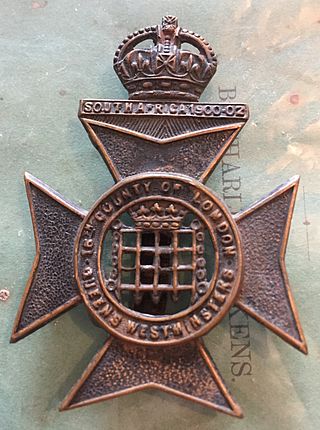
The Queen's Westminsters were an infantry regiment of the Territorial Army, part of the British Army. Originally formed from Rifle Volunteer Corps, which were established after a French invasion scare of 1859. The unit became part of the newly established London Regiment on the formation of the Territorial Force in 1908. It was subsequently amalgamated in 1921 with the Civil Service Rifles, and became a territorial Battalion of the King's Royal Rifle Corps in 1937. It ceased to exist as separate entity after it was amalgamated in 1961.
The Robin Hood Battalion was a unit of the Volunteer Force of the British Army and Territorial Force, later the Territorial Army. The battalion served as infantry during the 1916 Easter Uprising in Dublin and then served on the Western Front during World War I. In the 1930s it re-roled as an anti-aircraft unit and served in World War II, including North-western Europe from June 1944 to May 1945.

RADA Studios is a theatrical venue in Chenies Street in Bloomsbury, just to the east of Tottenham Court Road in the West End of London. Owned by the Royal Academy of Dramatic Art (RADA), the building contains rehearsal rooms, meeting rooms, and the 200-seat Studio Theatre.
The 1st Isle of Wight Rifle Volunteers, later the 8th Battalion, Hampshire Regiment, but known informally as the 'Isle of Wight Rifles', was an auxiliary unit of the British Army formed to defend the Isle of Wight after a mid-19th Century invasion scare. During World War I it fought in the Gallipoli Campaign, taking part in the calamitous attack at Suvla Bay, and later at the battles of Gaza and Megiddo in Palestine. Between the wars it was converted to coast defence artillery and served in this role on the Isle of Wight throughout World War II. One battery was sent to reinforce the garrison of Tobruk, where it was captured in 1942. Postwar the unit converted to the air defence role, then reverted to infantry, and its successors continue in today's Army Reserve.
The Paddington Rifles was a unit of the Territorial Army.

Fulham House is a former military installation at 87 Fulham High Street, Fulham, London. It is a Grade II listed building.

The City of London Rifles (CLR) was a volunteer regiment of the British Army, originally raised as the 'Printers' Battalion'. It saw a great deal of action as an infantry regiment in World War I. During World War II it served in the air defence role, first as a searchlight regiment in the United Kingdom, and later as an anti-aircraft artillery regiment in North West Europe.

Yeomanry House is a drill hall used by the London University Officer Training Corps in Handel Street, Bloomsbury, London.
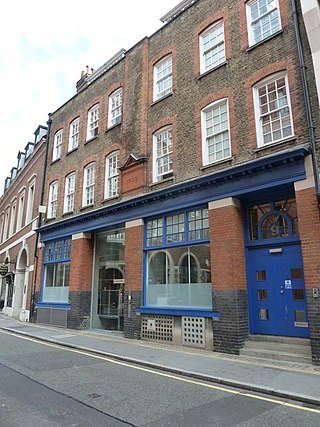
The Tufton Street drill hall is a former military installation on Tufton Street, Westminster, London.
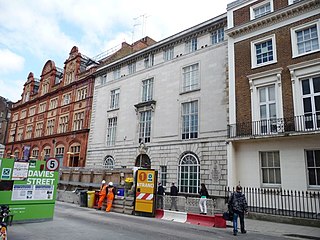
The Davies Street drill hall is a former military installation in Davies Street, London.

The Iverna Gardens drill hall is a military installation in Kensington, London.

The Buckingham Gate drill halls were military installations at 58 and 59 Buckingham Gate, London.
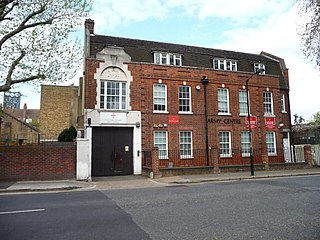
The Braganza Street drill hall is a military installation in Braganza Street, Walworth.
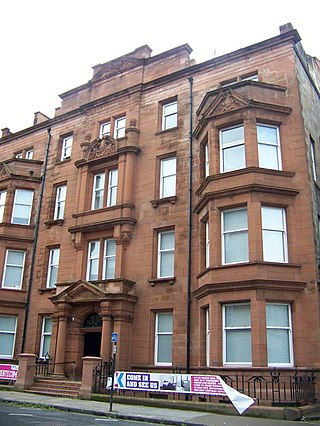
The West Princes Street drill hall is a former military installation in Glasgow, Scotland.
















